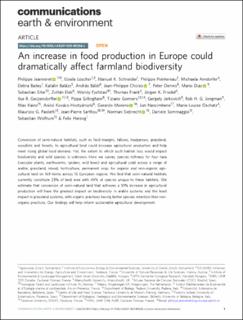| dc.contributor.author | Jeanneret, Philippe | |
| dc.contributor.author | Lüscher, Gisela | |
| dc.contributor.author | Schneider, Manuel K. | |
| dc.contributor.author | Pointereau, Philippe | |
| dc.contributor.author | Arndorfer, Michaela | |
| dc.contributor.author | Bailey, Debra | |
| dc.contributor.author | Balázs, Katalin | |
| dc.contributor.author | Báldi, András | |
| dc.contributor.author | Choisis, Jean-Philippe | |
| dc.contributor.author | Dennis, Peter | |
| dc.contributor.author | Díaz, Mario | |
| dc.contributor.author | Eiter, Sebastian | |
| dc.contributor.author | Elek, Zoltán | |
| dc.contributor.author | Fjellstad, Wendy Jane | |
| dc.contributor.author | Frank, Thomas | |
| dc.contributor.author | Friedel, Jürgen Kurt | |
| dc.contributor.author | Geijzendorffer, Ilse R. | |
| dc.contributor.author | Gillingham, Pippa | |
| dc.contributor.author | Gomiero, Tiziano | |
| dc.contributor.author | Jerkovich, Gergely | |
| dc.contributor.author | Jongman, Rob H. G. | |
| dc.contributor.author | Kainz, Max | |
| dc.contributor.author | Kovács-Hostyánszki, Anikó | |
| dc.contributor.author | Moreno, Gerardo | |
| dc.contributor.author | Nascimbene, Juri | |
| dc.contributor.author | Oschatz, Marie-Louise | |
| dc.contributor.author | Paoletti, Maurizio Guido | |
| dc.contributor.author | Sarthou, Jean-Pierre | |
| dc.contributor.author | Siebrecht, Norman | |
| dc.contributor.author | Sommaggio, Daniele | |
| dc.contributor.author | Wolfrum, Sebastian | |
| dc.contributor.author | Herzog, Felix | |
| dc.date.accessioned | 2022-02-17T14:34:38Z | |
| dc.date.available | 2022-02-17T14:34:38Z | |
| dc.date.created | 2021-09-08T14:21:21Z | |
| dc.date.issued | 2021-09-02 | |
| dc.identifier.citation | Communications Earth & Environment. 2021, 2 . | en_US |
| dc.identifier.issn | 2662-4435 | |
| dc.identifier.uri | https://hdl.handle.net/11250/2979791 | |
| dc.description.abstract | Conversion of semi-natural habitats, such as field margins, fallows, hedgerows, grassland, woodlots and forests, to agricultural land could increase agricultural production and help meet rising global food demand. Yet, the extent to which such habitat loss would impact biodiversity and wild species is unknown. Here we survey species richness for four taxa (vascular plants, earthworms, spiders, wild bees) and agricultural yield across a range of arable, grassland, mixed, horticulture, permanent crop, for organic and non-organic agricultural land on 169 farms across 10 European regions. We find that semi-natural habitats currently constitute 23% of land area with 49% of species unique to these habitats. We estimate that conversion of semi-natural land that achieves a 10% increase in agricultural production will have the greatest impact on biodiversity in arable systems and the least impact in grassland systems, with organic practices having better species retention than non-organic practices. Our findings will help inform sustainable agricultural development. | en_US |
| dc.language.iso | eng | en_US |
| dc.publisher | Springer Nature | en_US |
| dc.rights | Navngivelse 4.0 Internasjonal | * |
| dc.rights.uri | http://creativecommons.org/licenses/by/4.0/deed.no | * |
| dc.title | An increase in food production in Europe could dramatically affect farmland biodiversity | en_US |
| dc.type | Peer reviewed | en_US |
| dc.type | Journal article | en_US |
| dc.description.version | publishedVersion | en_US |
| dc.rights.holder | © The Author(s) 2021 | en_US |
| dc.source.pagenumber | 8 | en_US |
| dc.source.volume | 2 | en_US |
| dc.source.journal | Communications Earth & Environment | en_US |
| dc.identifier.doi | 10.1038/s43247-021-00256-x | |
| dc.identifier.cristin | 1932509 | |
| dc.relation.project | Norges forskningsråd: 194051 | en_US |
| dc.relation.project | EC/FP7/227161 | en_US |
| dc.source.articlenumber | 183 | en_US |
| cristin.ispublished | true | |
| cristin.fulltext | original | |
| cristin.qualitycode | 1 | |

